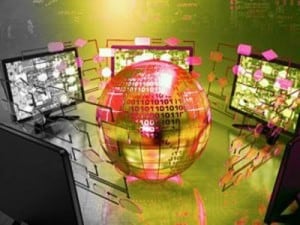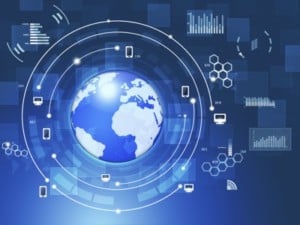 ERP I, ERP II, & ERP III Abstract
ERP I, ERP II, & ERP III Abstract
ERP applications integrate enterprise operations within and across enterprise legal entities, or company codes.
ERP ii (or ERP 2) applications extend supply functionality to external enterprises (generally vendor-affiliated companies or enterprises) to reduce cost, improve supply chain efficiency, and perform collaborative innovation.
ERP iii (or ERP 3) enterprises go to the next level as they integrate the ERP and ERP ii functionality to include customers and the sales side of the marketplace into enterprise operations. Your customers become active participants in your business.
Moving To the Border-less Enterprise
I have read extensive material about the enterprise applications and the next generation of ERP. Some suggest that ERP systems were just manufacturing tools (see e.g. ERPwire article on major differences between ERP vs. ERP ii). Others suggest ERP ii systems were little more than an extension of ERP functionality to new industry sectors. In my opinion, this is a completely misplaced assessment. Changing industry sectors does not change what an ERP application does, so a broader definition is more appropriate.
Before we go into the details and background of each of the three generations of enterprise applications, here are my definitions for ERP, ERP ii, and ERP iii systems:
ERP
An ERP (Enterprise Resource Planning) system integrates virtually all operational business functions and processes, automating entries to finance and reporting within the enterprise (the legal entity or entities that make up an entire company no matter where its operations are). ERP systems focus almost exclusively on operational excellence value propositions of process efficiency and automation.
ERP II (second generation ERP, ERP 2)
Through collaboration, SOA, and other interface, data exchange, or interaction methods, the ERP ii systems move beyond Enterprise boundaries (or a basic ERP system) and into the vendor space, including the supply, design, and engineering collaboration areas. ERP ii systems continue to enhance operational excellence and introduce a measure of the innovation value proposition.
ERP III (third generation ERP, ERP 3)
Through collaboration, direct contact, social media, and various data streams within and outside of the enterprise, ERP iii integrates marketplace fans and critics into the extended ERP and ERP ii organizations. This integration of the customer and vendor creates a constructive dialog and exchange of information to innovate, produce, and then sell/distribute better products or services. This closes the value proposition loop by going outside of the enterprise boundaries and finding ways to bring customer input, needs, wants, and insight into the enterprise. ERP iii systems create a strong synergy between innovation and customer focus.
ERP Defined
The acronym ERP literally stands for “Enterprise Resource Planning.” And this is exactly where I disagree with the ERPwire definition proposal. Just a manufacturing system or MES (Manufacturing Execution System) is not an enterprise system at all.
As the university studies and academic literature note, ERP systems are “a single instance of data, a full process chain of dependencies” (see Change Management Strategies and Knowledge Transfer Processes for a Successful SAP Project citing Kallinikos, 2004).
In the ERP industry we (consultants and integrators) frequently refer to any ERP system as a type of back office application or system. By back office, we are referring to company-centered business functions in a single database, or a single system of record. Back office processes are fully within the border and boundary of the enterprise.
In 2000, in an article addressing ERP ii, Gartner noted that they had defined ERP in 1990:
In 1990, Gartner defined ERP, establishing a new vision for the resource planning domain. That vision centered on resource planning and inventory accuracy, as well as visibility beyond the plant and throughout the manufacturing enterprise, regardless of whether the enterprise was a process manufacturer, discrete manufacturer or both. ERP has since appeared in different “flavors.” Extended ERP reflected the fact that many nonmanufacturing industries turned to ERP systems for “backbone” financial transaction processing capabilities (Bond, et. al., 2000 pg. 2, note 2).
That article went on to note the accepted definition (in 2000 and beyond):
Despite [the] original definition, ERP has become the accepted term for back-office transaction processing systems, regardless of the industry or region (Bond, et. al., 2000 pg. 3).
The definition I have provided is as comprehensive as the original Gartner proposal and includes the later understanding of the application to more industries and business functions.
ERP Focuses on the Operational Excellence Value Proposition
To understand the operational excellence perspective, see the more detailed explanation of the functions and operations of an ERP system under the section “What is SAP?” ( https://www.iitrun.com/define-sap ).
I generally categorize all system efforts and business functions into one of three value proposition buckets:
- operational excellence (ERP),
- innovation (ERP ii),
- and customer focus (ERP iii).
The ERP context is almost exclusively focused on the operational excellence portion of business back office transactional processing.
ERP vs. ERP ii — What is ERP ii?
The next generations of Enterprise applications, or ERP ii systems, extend the back office ERP system processing to the extended supply chain, and the enterprise into the supply chain outside of their legal entity borders as an active participant. This would include VMI (Vendor Managed Inventory) processing and KANBAN type demand and supply signals to vendors for JIT (Just In Time) stock management. However, ERP ii’s reach goes beyond that– it addresses the innovation portion of the value proposition.
SAP includes ERP ii type extended supply chain applications such as SRM (Supplier Relationship Management), APO (Advanced Planning and Optimization), and PLM (Product Lifecycle Management) to move the supply chain beyond the enterprise borders.
ERP II Creates Collaboration Hubs Beyond Planning and Distribution Functions
Together with the extended supply chain applications, a number of various exchanges such as common catalogs are published to the web and integrate with their customer ordering. Some examples of external exchanges can be seen in initiatives such as “Covisint” for the automotive industry, or Grainger’s online catalog system (although it is not a competitive-based platform like Covisint), and many others.
One of the key functions or features of ERP ii systems is supply chain or vendor collaboration, which extends to engineering design and development. Most enterprises with SRM systems use this to focus on cost reductions, vendor competition, and supply chain efficiencies. They are generally geared to the operational excellence system domain, but ERP ii offers a lot of untapped possibility.
Primarily, ERP ii functionality allows active collaboration with vendors to reduce cost, improve quality, reduce extended supply chain cycle times, and even co-engineer (or co-develop) better products and services.
Many ERP ii solutions now include some type of built-in reverse auctions, where companies can place requirements out for competitive bids in various formats. These exchanges might include data interchange methods such as EDI (Electronic Data Interchange) or other standards compliant communication protocols, but they are much more– they are active collaboration hubs. Together with these collaboration hubs, SOA extensions extend collaboration and engineering design work to the extended supply chain.
How Has SAP Implemented ERP ii System?
SAP has created an entire collaboration network called the SAP Community Network or SCN (http://scn.sap.com) where customers, vendors, consultants, and any interested party can exchange information, ideas, or dialog. SAP has implemented ERP ii systems internally through the development of specialized vendor partnerships called Ecohub (http://ecohub.sdn.sap.com/). Here, vendors, partners, or other firms with specialized SAP solutions can integrate and promote their offerings to enhance SAP’s various software offerings. Along with that, Ecohub offers code exchanges, “how-to” articles, discussion forums, and many other types of collaborative information exchanges. This is similar to what I proposed a few years ago when I wrote “SAP, ERP III, SOA — Learning Organizations through Social Media Collaboration.”
Operational Excellence and Innovation Value Propositions
ERP ii systems integrate the external vendors and suppliers into enterprise processes so they directly impact productivity, cost, and efficiency. Some elements of ERP ii include engineering staff augmentation for free or at a very reasonable rate to the “customer company,” as a value-added service from vendors. A vendor that can augment engineering functions has higher customer retention; in turn, the customer companies may have higher quality and lower cost products or services.
SAP’s ERP offerings include PLM (Product Lifecycle Management) with CAD integration for several off the shelf CAD programs. Although the PLM functionality is primarily used for internal engineering processes it can be pushed out into the extended supply chain for collaborative engineering and design. Properly structured and implemented collaboration can improve innovation. This is in conjunction with other integrated application offerings, such as SRM and APO.
By extending engineering or collaboration functions outside of the enterprise, but still within the supply chain, innovation can be introduced into the ERP ii enterprise (see the entire series on Process Execution of Business and IT Innovation). However, ERP ii systems primarily provides additional operational excellence through extended supply chain processing. Very few companies have succeeded at collaborating with the extended supply chain with extended engineering capabilities, or vendor insight to produce significant innovation. Most ERP ii systems only work to extend the supply chain beyond the boundaries of the enterprise for cost savings and efficiencies (operational excellence).
Using SOA (Service Oriented Architecture) for Creating ERP ii and ERP iii Enterprises
The promise of ERP ii system success that moves toward ERP iii (discussed in a moment) is SOA or Service Oriented Architecture. In layman’s terms, SOA is the ability to create a set of talking points from any internal system to the external systems.
They are the data structures and schemas that are published for other systems to interact with and help create the framework for the borderless enterprise.
What is ERP iii and How Does it Go Beyond ERP ii?
ERP iii addresses the final domain of enterprise class applications by addressing the customer focus value proposition. ERP iii extends technology capabilities, which brings collaboration with customers and the broader marketplace into the enterprise system. This goes way beyond what we currently refer to as CRM (Customer Relationship Management) systems. Today’s CRM applications still operate within the walls of the enterprise and mainly manage the sales force, rather than moving the enterprise out into the wider marketplace and direct interaction with customers.
ERP iii from a high level is fairly easy to define; however, it is difficult to predict what it will be in a few years. The areas that ERP iii touches are in a rapid state of change because of the dynamic nature of social media and the global marketplace.
ERP iii Defined
- ERP applications integrate enterprise operations within and across enterprise legal entities, or company codes.
- ERP ii applications extend supply functionality to external enterprises (generally vendor-affiliated companies or enterprises) to reduce cost, improve supply chain efficiency, and perform collaborative innovation.
- ERP iii enterprises go to the next level of integrating the ERP and ERP ii functionality to include customers and the sales side of the marketplace in general.
The end state of the ERP iii enterprise would include a dialog between customers (and potential customers), the ERP organization, and the extended supply chain so that even suppliers would participate in the sales side of the marketplace. Because there is little or no information in the marketplace about ERP iii direction and design, I am offering a more detailed definition here:
Through collaboration, direct contact, social media, and various data streams within and outside of the enterprise, ERP iii integrates marketplace fans and critics into the extended ERP and ERP ii organizations. The integration of customers and vendors beyond the enterprise boundaries a constructive dialog or information exchange helps innovate, produce, and then sell (or distribute) better products or services.
ERP iii will create the “borderless enterprise” by bringing together a host of technology sources such as:
- Collaboration tools (within the enterprise and across the supply chain and marketplace)
- Social media
- Internet technologies
- SOA
- Smart information integration and synthesis (specialized search with analytics or within specific information domains). An early example of this type of search is a web service called “Lijit.” Lijit allows you to manually assign searchable information sources for a customized, high-value “search engine.”
- Extended marketing analytics that are like tracking cookies but less invasive, using additional sources of information and research beyond the web (a good example is a grocery store checkout programs that automatically print coupons on the back of your store receipts based on what you just purchased).
- Direct customer collaboration (we see early examples of this in the Dell “designed by me” and “I made Windows 7” television commercial marketing campaigns).
The Future of ERP iii Systems
Within the extended SAP enterprise (which is my area of expertise), I see many of the seeds of ERP iii germinating and beginning to grow. Even though the initial “green shoots” are there for an ERP iii revolution, I don’t anticipate that occurring for several years within SAP.
Today SAP has the following:
- Active, country-specific SAP User Groups (xSUG, in America is it ASUG) with “influence councils”
- Community forums (previously mentioned)
- “Mentor Groups” within the community network
While these all contain the seeds of ERP iii outlets, I do not see much raw material being converted into application enhancements to directly address business marketplace demands. ERP iii still offers too many technical solutions and not enough solutions for genuine business needs.
ERP iii integrates marketplace fans and critics into the extended ERP and ERP ii organizations to innovate, produce, and then sell (or distribute) customer-centric products or services.
I doubt that the integration of more social media will move the ERP iii needle much further. Like any other company that embarks on this type of transformational exercise, SAP must begin to use their well-established outlets to drive innovation and meet marketplace requirements (see the entire series on Process Execution of Business and IT Innovation).
Social Media and ERP iii
Social media outlets such as Facebook and Twitter (X) need to become more sophisticated to produce meaningful differences in business-centered innovation or customer focus. That sophistication for business requires finding a means to use those outlets for genuine business competitive advantage.
Businesses will take some time to find new ways to tap into the collective marketplace consciousness through social media as they combat the massive number of what I refer to as “snake oil” salespeople. Social media in the enterprise will not be useful until the snake oil sales finally align actual business needs to areas of the enterprise (sales, marketing, HR recruiting, etc.) that align with business goals and directions (see Social Media Fads and the Risk to the Enterprise).
Before ERP iii systems are ready for the extended marketplace and for customer interaction, they need back office integration with social media (see ERP III – Is the Integration of Collaboration the Future of Enterprise Applications).
As social media and collaboration tools mature over the next ten or more years, corporations will finally build the ERP iii systems for integration into the wider marketplace. By then, the ERP ii systems will have finally matured to the point that some of them can provide meaningful integration among the enterprise, the entire supply chain, and the sales side of the marketplace in general.
ERP, ERP ii, and ERP iii Conclusion
Considering this specialized class of business systems through the lens of the high level value propositions of 1) operations, 2) innovations, and 3) customers, here is my summary:
ERP (Enterprise Resource Planning)
Primarily focused on the back office with a heavy emphasis on operations, automation, cost control, financial activity, and lagging business indicators of performance.
ERP ii (The Second Generation of Enterprise Resource Planning)
Extends back office processing functions and operations into the extended supply chain with a heavy emphasis on supply chain automation, additional efficiency, more cost control, and some vendor collaboration for limited innovation. This area of the application moves into the last mile of improvements, which can be more expensive to implement and yield lower returns. However, carried out properly with significant supply chain collaboration and joint engineering or development efforts, these improvements can provide innovative products or services, addressing both lagging indicators of cost control and efficiency while exploring leading indicators of new products or services.
ERP iii (The Next Generation of Enterprise Resource Planning)
Encompasses the integration of social media with new marketplace intelligence and analytics into the ERP ii enterprise. With a very simply “hub and spoke” idea, the enterprise will constitute the “hub” and extended supply chain vendors, engineers, and designers, together with customers and market analysis as some of the “spokes.” The ERP application will enable this, extended with collaboration and social media tools. The ERP, ERP ii, and ERP iii functions will all be integrated with new analytics and smart source search methods to integrate and synthesize trend, market, and product or service information. This will close the loop on the ERP ii innovation and bring a new customer-focused business paradigm into the enterprise that goes far beyond today’s CRM applications.
ERP iii state companies will be marketplace disrupters who are agile, nimble, and global. They will spot emerging trends and unmet customer demands (needs or wants) far more quickly and with greater ability than their peers. From those trends and customer needs, these companies will quickly execute innovation programs to develop new products and services to quickly fill those customer demands. The most advanced of these new disruptive innovators will be the companies that can intelligently synthesize all of the various data points to understand unarticulated customer demands.
======================
Bond, B., Genovese, Y., Miklovic, D., Wood, N., Zrimsek, B., and Rayner, N. (2000). ERP Is Dead — Long Live ERP II; Gartner Publications.
Kallinikos, J. (2004), “Deconstructing Information Packages. Organizational and Behavioral Implications of ERP Systems.” Information Technology and People, Vol. 17, No. 1, pp. 8-30.






Great job and good explanation about ERP
It is very good. Introduce me some books about ERP III, Please.
Hi!!
I have to say this is an excellent article.
i would like some information about the meaning of “3rd division ERP”. is it an old generation erp or erp III? what is the next level when upgrading a 3rd division erp?
Excellent article. Thanks for this
I am using this in my presentation at one of the prestigious institutes
hi
thanks alot for informatins.
they are comprehensive, but I need more information about ERP2, and what are the advantages ERP2?
best the regards
amer dehghan
msc student in management , university of tehran.
No matter the evolution of ERP Systems, the central keyword is ‘connection’. ERP connects people and information from different locations, depatments or times.